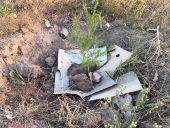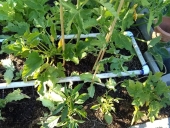HI!
We have 12 raised beds in our kitchen garden (and I just had to sit here and count them in my head and honest to God, I didn't think I had built that many!), resting on top of gravelly, sandy, packed soil. In the winter, when it rains steady, drainage can be an issue, with pools of standing water in parts of our back yard where the kitchen garden is. In the summer, that area gets hot - I think because all the gravel collects that heat during the day and gently let's it off at night. For this and many other reasons, including vanity, I built all of our raised beds 12 inches high and variety of lengths. We also have 3 metal horse troughs that are 24 inches high.
I filled the whole bottom half of our raised beds with smaller diameter logs and bark from evergreen trees (not cedar, though). Everything from twigs to branches 3 inches in diameter. Then I filled in the gaps with leaf litter and huckleberry boughs. I then inoculated every bed with several scoops of bunny manure. Then dressed the top half with 3/4 fish
compost and 1/4 soil mix. These beds are thriving this summer, with minimal rain fall, and we only really have to water when I plant new seeds and they are getting started. I've even started mulching with pine wood shavings from the feed store around the beds with tomatoes, sunchokes, cucumbers and strawberries, just to save even more water.
My thinking, which seems to be borne out now in our second season of heavy rotation in the raised bed kitchen garden is that the logs and wood debris really IS helping conserve water and that to take it to the next level, I may start adding a bit of permanent mulch on the top in the form of straw or wood shavings to lock in even more water. The wood debris acts like a sponge - a little contained, not too diverse "hugel-ish" bed. Added bonus is that it helped use up the endless supply of wood debris from a clearing project we did and firewood splitting.
I also don't pull the plants. I just snip them off at the soil line and leave the roots in the bed. In the fall, as everything is harvested and seed is collected, I just nip everything at the soil line, top dress with compost, and leave it for spring. This year, I'll do all that and then add straw mulch on top of everything and leave it all until spring. I continue to be amazed at how the soil settles and everything decomposing under it and that I always have to add at least 2 inches of compost in the fall.
Anyhow - good luck and have fun!





 1
1




 1
1








 2
2




 3
3




 1
1













